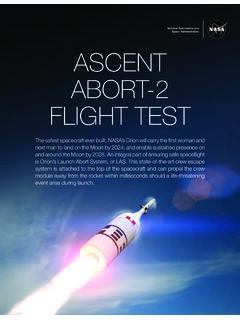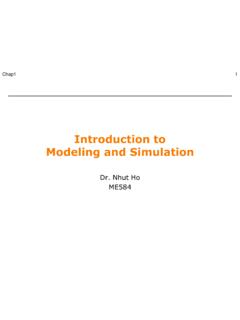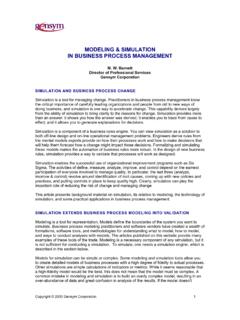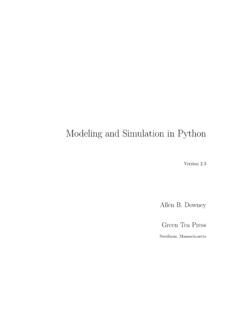Transcription of NASA Technology Roadmaps
1 NASA Technology RoadmapsTA 11: modeling , simulation , Information Technology , and ProcessingJuly 2015 The 2015 NASA Technology Roadmaps have been replaced with the 2020 NASA Technology Taxonomy and the NASA Strategic Technology Integration : The 2015 NASA Technology Roadmaps will be archived and remain accessible via their current Internet address as well as via the new 2020 NASA Technology Taxonomy Internet page. Please visit to see the NASA Technology RoadmapsTA 11: modeling , simulation , Information Technology , and ProcessingTA 11- 2 July 2015 ForewordNASA is leading the way with a balanced program of space exploration, aeronautics, and science research. Success in executing NASA s ambitious aeronautics activities and space missions requires solutions to difficult technical challenges that build on proven capabilities and require the development of new capabilities. These new capabilities arise from the development of novel cutting-edge technologies.
2 The promising new Technology candidates that will help NASA achieve our extraordinary missions are identified in our Technology Roadmaps . The Roadmaps are a set of documents that consider a wide range of needed Technology candidates and development pathways for the next 20 years. The Roadmaps are a foundational element of the Strategic Technology Investment Plan (STIP), an actionable plan that lays out the strategy for developing those technologies essential to the pursuit of NASA s mission and achievement of National goals. The STIP provides prioritization of the Technology candidates within the Roadmaps and guiding principles for Technology investment. The recommendations provided by the National Research Council heavily influence NASA s Technology prioritization. NASA s Technology investments are tracked and analyzed in TechPort, a web-based software system that serves as NASA s integrated Technology data source and decision support tool.
3 Together, the Roadmaps , the STIP, and TechPort provide NASA the ability to manage the Technology portfolio in a new way, aligning mission directorate Technology investments to minimize duplication, and lower cost while providing critical capabilities that support missions, commercial industry, and longer-term National 2015 NASA Technology Roadmaps are comprised of 16 sections: The Introduction, Crosscutting Technologies, and Index; and 15 distinct Technology Area (TA) Roadmaps . Crosscutting Technology areas, such as, but not limited to, avionics, autonomy, information Technology , radiation, and space weather span across multiple sections. The introduction provides a description of the crosscutting technologies, and a list of the Technology candidates in each NASA Technology RoadmapsTA 11: modeling , simulation , Information Technology , and ProcessingTA 11- 3 July 2015 Table of ContentsExecutive Summary.
4 11-4 Introduction .. Computing .. modeling .. simulation .. Information Processing ..11-10TA 11 .1: Computing ..11-12 Sub-Goals .. 11-12TA 11 .2: modeling ..11-18 Sub-Goals .. 11-18TA 11 .3: simulation ..11-28 Sub-Goals .. 11-28TA 11 .4: Information Processing ..11-41 Sub-Goals .. 11-41 Appendix ..11-55 Acronyms ..11-55 Abbreviations and Units ..11-57 Contributors ..11-58 Technology Candidate Snapshots.. 11-592015 NASA Technology RoadmapsTA 11: modeling , simulation , Information Technology , and ProcessingTA 11- 4 July 2015 Executive SummaryThis is Technology Area (TA) 11: modeling , simulation , Information Technology , and Processing, one of the 16 sections of the 2015 NASA Technology Roadmaps . The Roadmaps are a set of documents that consider a wide range of needed technologies and development pathways for the next 20 years (2015-2035). The Roadmaps focus on applied research and development activities.
5 The modeling , simulation , Information Technology , and Processing TA focuses on advances in foundational capabilities for flight computing and ground computing; physics-based and data-driven modeling , simulation , and software development; and information and data processing frameworks, systems, and standards. Taken as a whole, TA 11 has impact on most of the NASA Technology portfolio. The foundational modeling , simulation , information Technology , and processing technologies in this area enable the development of application-specific modeling , simulation , and information technologies as found throughout the other Technology Roadmaps . TA 11 technologies also form the base of Agency-wide capabilities needed to meet the ever-increasing modeling , simulation , information Technology , and processing demands of NASA s missions in exploration, science, and aeronautics. Hence, these technologies are an important component of solutions to NASA s greatest overarching goal of TA 11 is to develop computing, modeling and simulation , and information technologies that are the basis of new solution paradigms across the breadth of NASA s missions.
6 TA 11 focuses on enabling the NASA mission by developing modeling , simulation , information Technology , and processing technologies that ultimately increase NASA s understanding and mastery of the physical world. High-level goals for each of the major themes of the roadmap are shown in Table 1. These goals include development of technologies needed for transformational flight and ground computing; increased modeling productivity and fidelity throughout NASA s broad mission portfolio; simulations that enable management of uncertainty and risk across the entire system life cycle; and unprecedented increases in NASA s ability to effectively utilize its wealth of data, including observational, sensor, simulation , and test data. Table 1. Summary of Level 2 modeling , simulation , Information Technology , and ProcessingGoals: Develop computing, modeling and simulation , and information technologies that are the basis of new solution paradigms across the breadth of NASA s missions.
7 Enable the NASA mission through development of virtual technologies that increase NASA s understanding and mastery of the physical world. ComputingSub-Goals:Develop scalable, radiation-hardened flight processors, memory management and flight software to support more autonomous operations and data triage at the point of data collection. Exploit exascale supercomputing, data storage, and software development capabilities to enable 1,000 times larger mission-driven ModelingSub-Goals:Develop autonomous, integrated, and interoperable approaches for models and model development. Increase productivity, improve performance, and manage risk through improvements in autonomy and integration in modeling for NASA s future SimulationSub-Goals:Develop best-physics simulations of operative mechanisms that enable increases in system performance and management of uncertainty and risk across the entire lifecycle of NASA s distributed, heterogeneous, and long-lived mission Information ProcessingSub-Goals:Develop software frameworks and toolsets that efficiently and reliably manage greatly increased volume, variety, and velocity of data across the science, engineering, and mission data lifecycle while maintaining security of data.
8 Enable advanced missions, effective remote and human-system collaboration, and greater system and crew autonomy through advanced NASA Technology RoadmapsTA 11: modeling , simulation , Information Technology , and ProcessingTA 11- 5 July 2015 BenefitsSome of the major benefits of high-fidelity modeling and simulation , supported by high-performance computing and information processing, include expansion of the possible solution space enabling new design concepts; insight into the relationships between flight environments and system response; large-scale data analysis and integration that enables new scientific discoveries; training and decision-support systems that increase performance and safety while decreasing cost by using modeling and simulation directly in mission systems; near real-time numerical experimentation to explore mission trade space; and evaluation of complex systems throughout their lifecycle.
9 TA 11 technologies are broadly applicable to NASA s missions in exploration, science, and aeronautics. They impact not only the initial stages of mission planning but also the design, development, and certification process, and the long-term sustainment of vehicles and analysis of mission data. Ultimately, they will help to give decision makers the capabilities needed to manage risk, cost, and schedule for NASA s most demanding of 22015 NASA Technology RoadmapsTA 11: modeling , simulation , Information Technology , and ProcessingJuly 2015 Figure 1. Technology Area Strategic RoadmapTA 11 - 62 of 22015 NASA Technology RoadmapsTA 11: modeling , simulation , Information Technology , and ProcessingJuly 2015 Figure 1. Technology Area Strategic roadmap (Continued)TA 11 - 72015 NASA Technology RoadmapsTA 11: modeling , simulation , Information Technology , and ProcessingTA 11- 8 July 2015 IntroductionThe topic area of modeling , simulation , Information Technology , and Processing spans nearly the entire NASA mission portfolio (see Figure 1).
10 Although parts of TA 11 are discipline-specific, most of this Technology area (TA) enables future disciplinary modeling and simulation technologies as found throughout the other Technology Roadmaps . While the other roadmap efforts address needs from specific domain perspectives, TA 11 focuses on needed advances in flight and ground computing, foundational and crosscutting elements of modeling and simulation , and science and engineering information processing. In the present roadmap , modeling and simulation are listed separately as a result of the legacy of the previous version. However, they are highly interrelated, as seen in the roadmap contents, and are often referred to 2. Technology Area Breakdown Structure (TABS) Technology Areas for modeling , simulation , Information Technology , and Processing2015 NASA Technology RoadmapsTA 11: modeling , simulation , Information Technology , and ProcessingTA 11- 9 July ComputingComputing encompasses innovative approaches to flight and ground computing that have the potential to increase the robustness of future aerospace systems and science return on long-duration exploration missions.



















